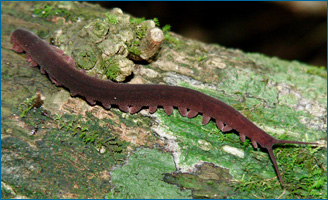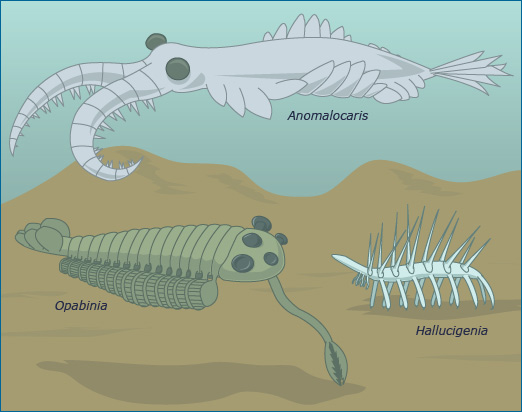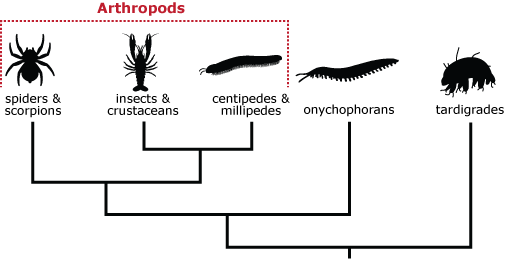
Eoperipatus totoro doesn’t look much like a fearsome predator. In fact, this two-inch long critter resembles nothing so much as a plush, candy-colored caterpillar with wriggly antennae. But this little known animal is no caterpillar. It is a velvet worm — a.k.a. an onychophoran, a group of organisms that today live in tropical regions and trap their insect prey using jets of sticky slime, a-la Spider-Man. Discovered in Vietnam and officially described just last month, this particular species may be new to science, but the onychophorans as a group have long been of interest to biologists for their important role in evolutionary history…
Where's the evolution?
To understand why the rare and frankly esoteric velvet worm is so fascinating to evolutionary biologists, you first need to know a little bit about lagerstatten and the Cambrian Period. Lagerstatten are fossil mother lodes — dense assemblages of well-preserved fossils that often shed light on the workings of entire ancient ecosystems. Two lagerstatten preserve a host of strange-looking animals from the Cambrian Period, the evolutionary dawn of animals themselves. The Burgess Shale in Canada, which is about 505 million years old, and the more recently discovered Chengjiang formation in China, which dates to 520 million years old contain the remains of a host of odd-looking sea dwellers — and not just their hard parts, but the soft body parts of animals that would normally rot away, giving paleontologists a remarkably clear glimpse of the life that inhabited Earth’s ancient oceans — and it is strange view indeed! Five-eyed, fluke-like critters paddled around and hoovered up food with a clawed, tube mouth, wormy creatures armed with long, pincushion spikes wandered around the seafloor, and large, squishy animals with armored, circular mouths and jointed tusks undulated overhead.
Since the Burgess Shale was first discovered in 1909, scientists have wondered how these ancient animals connect to those alive today. Are these creatures actually close relatives of modern species (albeit, strange-looking ones) — or do these lineages represent failed evolutionary experiments, forays into body plans that didn’t survive and aren’t represented anywhere on Earth today? After much debate, the short answer seems to be, some are, some aren’t. The five-eyed fluke, now known as Opabinia? An extinct lineage with no close, modern relatives. That pincushion worm, now called Hallucigenia? Well, scientists have gone back and forth on that. The first paleontologists to study this creature surmised that it walked around on its spikes and had a row of waving tubes down its back. Unsurprisingly, they hypothesized that it had no modern corollaries. But in the 1990s additional fossils revealed that the tubes actually came in pairs and probably served as fleshy, tube feet, with the spikes pointed up for defense, turning the whole reconstruction of the species on its head. Further studies suggested that the mysterious Hallucigenia was actually a spiky, sea-dwelling onychophoran!
Recent investigations of Hallucigenia fossils are also consistent with this idea. When Canadian and British scientists used microscopes to look closely at Hallucigenia‘s spikes, they found that they were covered in tiny scales and constructed like stacks of very pointy ice cream cones. Since the cone-shaped jaws and claws of modern onychophorans are constructed in the same way, this trait serves as further evidence that the two lineages are closely related. It seems likely that this cone-in-cone construction of hard parts was inherited by both modern onychophorans and Hallucigenia from their common ancestor. In addition, the tiny scales and unique construction of Hallucigenia‘s spikes helps solve a paleontological mystery. Many sediments from the Cambrian — ones that preserve fossils less perfectly than the Burgess Shale or the Chengjiang formation — are full of mysterious tiny shells that weren’t easy to identify. Now it appears that many of those shells are actually Hallucigenia spikes (minus the rest of the velvet worm) and that this creature lived not just in the ecosystems preserved in lagerstatten, but was common and lived all over the world.
Biologists are particularly interested in onychophorans because they can help us understand the evolution of one of the most successful groups of animals ever to live on Earth: the arthropods, a clade of segmented animals with jointed legs, that includes insects, spiders, and crustaceans. Onychophorans are not arthropods — their squishy tube legs make that clear — but they do seem to be closely related to arthropods. For one thing, even though they are soft-bodied, onychophorans have to molt in order to grow, just as arthropods do. And even though they don’t look segmented from the outside, some of the interior organs of an onychophoran are arranged serially, much like those of a segmented animal. Onychophorans even breathe like insects do — through a system of holes and tubes throughout their body called tracheae. Genetic data also support this idea. Genetic sequences from arthropods, onychophorans, and other animals suggest that onychophorans occupy the branch of the tree of life that is right next door to that of the arthropods. The two groups are sister taxa — i.e., each others’ closest relatives. Knowing which organisms occupy the branches adjacent to the arthropods’ is important because it helps scientists reconstruct what the ancestors of these groups were like, and correspondingly, how modern arthropods evolved.
Onychophorans belong to a clade that has been on Earth for half-a-billion years and is closely related to arthropods. Yet these fuzzy creatures are not “precursors” to armored dragonflies and lobsters. Rather, ancient onychophorans lived alongside the lineage that gave rise to arthropods and shared many traits with that ancestor. Modern onychophorans provide a window on the past, but occupy their own branch on the tree of life — one that has yet to be fully explored if the newly discovered Vietnamese species is any indication!
Primary literature:
- Campbell, L. I., Rota-Stabelli, O., Edgecombe, G. D., Marchioro, T., Longhorn, S. J., Telford, M., J., ... Pisani, D. (2011). MicroRNAs and phylogenomics resolve the relationship of Tardigrada and suggest that velvet worms are the sister group of Arthropoda. Proceedings of the National Academy of Sciences USA. 108: 15920-15924. Read it »
- Caron, J., Smith, M. R., and Harvey, T. H. P. (2013). Beyond the Burgess Shale: Cambrian microfossils track the rise and fall of hallucigeniid lobopodians. Proceedings of the Royal Society B. 280: 20131613. Read it »
- Oliveira, I. S., Schaffer, S., Kvartalnov, P. V., Galoyan, E. A., Palko, I. V., Weck-Heimann, A., ... Mayer, G. (2013). A new species of Eoperipatus (Onychophora) from Vietnam reveals novel morphological characters for the South-East Asian Peripatidae. Zoologischer Anzeiger. 252: 495-510. Read it »
News articles:
- A description of the new velvet worm species from LiveScience
- A newspaper article summarizing the recent research on Hallucigenia's spines from the Rocky Mountain Outlook
Understanding Evolution resources:
- How are lagerstatten similar to and different from other strata that preserve fossils?
- Describe two traits that Hallucigenia and modern onychophorans both inherited from their common ancestor.
- Five years ago, paleontologists thought that Hallucigenia was a rare animal in Cambrian ecosystems. Today, they think it was a common organism. Describe the evidence and reasoning that prompted this shift.
- In your own words, explain what sister taxa are.
- List a pair of sister taxa shown on the phylogeny in the article above — other than onychophorans/arthropods.
- Would it be accurate to describe the newly discovered onychophoran species as a living fossil? Explain your reasoning.
- Teach about the Cambrian animals and the early evolution of arthropods: This interactive investigation for grades 6-12 delves into the amazing world of the arthropods and examines their success and their evolutionary constraints.
- Teach about how scientists learn about the past: This web-based module for grades 6-12 provides students with a basic understanding of how fossils can be used to interpret the past.
- Teach about using evolutionary trees to understand evolutionary history: In this classroom activity for grades 9-16, students focus on the evolution of three species of lizards using real data sets — geographical and geological data, then morphology, and finally molecular data — to determine possible phylogenetic explanations.
- Campbell, L. I., Rota-Stabelli, O., Edgecombe, G. D., Marchioro, T., Longhorn, S. J., Telford, M., J., ... Pisani, D. (2011). MicroRNAs and phylogenomics resolve the relationship of Tardigrada and suggest that velvet worms are the sister group of Arthropoda. Proceedings of the National Academy of Sciences USA. 108: 15920-15924.
- Caron, J., Smith, M. R., and Harvey, T. H. P. (2013). Beyond the Burgess Shale: Cambrian microfossils track the rise and fall of hallucigeniid lobopodians. Proceedings of the Royal Society B. 280: 20131613.
- Conway-Morris, S. (2000). The Crucible of Creation. Oxford University Press.
- Gould, S. J. (1990). Wonderful Life. W. W. Norton & Company.
- Oliveira, I. S., Schaffer, S., Kvartalnov, P. V., Galoyan, E. A., Palko, I. V., Weck-Heimann, A., ... Mayer, G. (2013). A new species of Eoperipatus (Onychophora) from Vietnam reveals novel morphological characters for the South-East Asian Peripatidae. Zoologischer Anzeiger. 252: 495-510.


